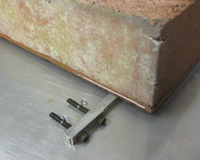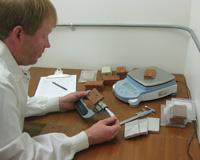


ASTM C 67 initial rate of absorption test. The test measures the initial suction of the masonry, a quality that influences the bonding characteristics of newly laid brick. The test can be modified with methods derived from European test standards to measure the longer term capillarity of the brick. This can inform the relative rate and preferred path of rainwater through the masonry assembly.
Frost dilatometry testing. Thin brick slices are subjected to freeze-thaw cycles at various saturation levels to determine the critical degree required to result in expansion. The test data can be input into a WUFI model of the building envelope along with density, absorption, and capillary uptake.
Brick Testing
Understanding the engineering properties of masonry units is critical to understanding how the masonry responds to stress, resists or transmits moisture and vapor, or remains durable in severe climates. ASTM C 67 covers a variety of strength, absorption, and durability tests that are generally applied to understand the bulk properties of structural clay brick and tile. Highbridge routinely performs these tests for both new and existing masonry units often in conjunction with mortar analysis.
Highbridge also performs standardized and non-standardized tests that provide more refined data such as vapor transmissivity, longer-scale liquid water capillarity rates, and critical degree of saturation for frost dilation.

